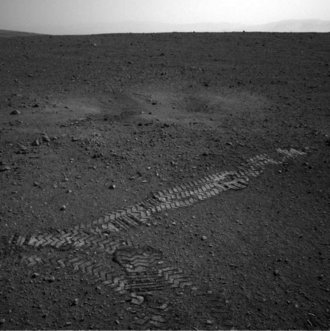NASA's Mars Rover Curiosity Makes First Test Drive

NASA's Mars rover Curiosity on Wednesday made its first test drive, leaving wheel tracks near its landing spot -- now dubbed "Bradbury Landing" in honor of late science fiction author Ray Bradbury.
"Curiosity today had its first successful drive on Mars. We have a fully functioning mobility system on our rover," said Matt Haverly, the lead rover planner at NASA's Jet Propulsion Laboratory (JPL) in Pasadena, California.
The $2.5 billion craft -- which landed in Gale Crater on the Red Planet on August 6 -- drove about four meters (yards) forward, before turning right at a 90 degree angle and moving backwards a few meters.
"This placed the rover roughly 20 feet (6 meters) from the spot where it landed 16 days ago," NASA, the U.S. space agency, said in a statement.
An image taken by the rover clearly shows its wheel tracks on Martian soil. More tests will be conducted before Curiosity takes off on its full mission to search for signs of life on the Red Planet.
"We are 16 days into a two-year mission," said Pete Theisinger, Mars Science Laboratory project manager at the JPL.
"We haven't exercised the sample gathering capability, which is a key, key, key element of the rover's science mission," Theisinger added.
"So, as good as it's gone, and as wonderful as it is, we still only checked off about two of the level-one requirement boxes: we launched on time, landed on Mars, and we have a long way to go before this mission reaches its full potential."
NASA said it had approved the Curiosity team's proposal to rename the touchdown site in tribute to Bradbury, the author of "The Martian Chronicles" and "Fahrenheit 451" who would have turned 92 on Wednesday. He died in June.
"In his honor, we declared the place that Curiosity touched down to be forever known as 'Bradbury Landing,'" said Michael Meyer, the lead scientist for NASA's Mars Exploration Program.
"Today would have been Ray Bradbury's 92nd birthday, but he already reached immortality with the hundreds of short stories he's written and nearly 50 books. His books have truly inspired us," Meyer said.
"'The Martian Chronicles' have inspired Curiosity and opened our minds to the possibility of life on Mars."
Scientists do not expect Curiosity to find aliens or living creatures but they hope to use it to analyze soil and rocks for signs the building blocks of life are present and may have supported life in the past.
The project also aims to study the Martian environment to prepare for a possible human mission there in the coming years. U.S. President Barack Obama has vowed to send humans to the planet by 2030.
Prior to the naming of Bradbury Landing, the JPL released a video of Bradbury among NASA scientists, gathered on the occasion of the arrival of the Mars probe Mariner 9 in orbit around the Red Planet in November 1971.
At the time, Bradbury said: "I was hoping that during the last few days, as we got closer to Mars and the dust cleared, that we would see a lot of Martians standing with huge signs saying, 'Bradbury was right.'"
The prolific author, who died in Los Angeles, helped to popularize the science fiction genre. His stories about life on Mars captured the imaginations of many researchers and scientists.
"He was a friend of JPL," said Theisinger, noting that Bradbury last visited the JPL in 2009.



